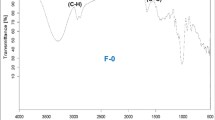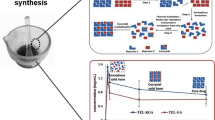Abstract
The present study aims to create a controlled-release system through the preparation and characterization of starch cellulose acetate co-acrylate (SCAA) polymer for application as a carrier for cancer drugs. SCA was prepared from maize starch and different ratios of cellulose acetate. The obtained product SCA was reacted with acrylic acid monomer to give cellulose acetate co-acrylate. The best ratio of starch to cellulose acetate was found to be 90:10, giving a stable product with acrylic acid. The cancer drug 8-(2-methoxyphenyl)-3,4-dioxo-6-thioxo-3,4,6,7-tetrahydro-2h-pyrimido[6,1-c]-[1,2,4]triazine-9-carbonitrile was dissolved in dimethylformamide then added gradually at the end of the previous reaction under stirring for 15 min. The prepared polymers with and without the drug were characterized by Fourier-transform infrared spectroscopy. Cuboids discs of the prepared polymer/drug were subjected to drug release in aqueous media at different pH values. The release was measured spectrophotometrically. It was found that the release rate depends on the pH of the aqueous medium as well as on the concentration of the drug loaded onto the polymer carrier. Above pH 12, the polymer containing the drug degraded completely within 1 h after being subjected to alkaline media. Sustained release of drug extended to about 20 days. The amount released depended on the pH of the media in the following order: basic media > acidic media > neutral. According to Higuch’s equation, the diffusion coefficient was found to be 4.2 × 10−8 and 5.5 × 10−8 cm s−1 for the two evaluated concentrations (1.5 and 2 %) of active organic compound (drug).








Similar content being viewed by others
References
H. Yueying, Z. Yan, G. Chunhua, D. Weifeng, L. Meidong, Micellar carrier based on methoxy poly(ethylene glycol)—blockpoly (ε caprolactone) block copolymers bearing ketone groups on the polyester block for doxorubicin deliverys. J. Mater. Sci. 21, 567–574 (2010)
S. Bontha, A.V. Kabanov, T.K. Bronich, Polymer micelles with crosslinked ionic cores for delivery of anticancer drugs. J. Control. Release 114, 163–174 (2006)
S. Dhawan, K. Dhawan, M. Varma, V.R. Sinha, Applications of poly(ethylene oxide) in drug delivery systems, part II. Pharm. Technol. 29, 82–96 (2005)
D.B. Shenoy, M.M. Amiji, Poly(ethylene oxide)-modified poly(ε-caprolactone) nanoparticles for targeted delivery of tamoxifen in breast cancer. Int. J. Pharm. 293, 261–270 (2005)
C.S. Pereira, A.M. Cunha, R.L. Reis, New starch-based thermoplastic hydrogels for use as bone cements or drug-delivery carriers. J. Mater. Sci. 9, 825–833 (1998)
Y. Xu, V. Miladinov, M.A. Hanna, Synthesis and characterization of starch acetates with high substitution. Cereal Chem. 81, 735–740 (2004)
H. Lua, L. Zhanga, C. Wanga, R. Chen, Preparation and properties of new micellar drug carriers based on hydrophobically modified amylopectin. Carbohydr. Polym. 83, 1499–1506 (2011)
I. Silva, M. Gurruchaga, I. Goni, Physical blends of starch graft copolymers as matrices for colon targeting drug delivery systems. Carbohydr. Polym. 76, 593–601 (2009)
A.I. Khalf, D.E. El Nashar, N.A. Maziad, Effect of grafting cellulose acetate and methylmethacrylate as compatibilizer onto NBR/SBR blends. Mater. Des. 31, 2592–2598 (2010)
O.A. Fathalla, I.F. Zeid, M.E. Haiba, A.M. Soliman, Sh.I. Abd-Elmoez, W.S. El-Serwy, Synthesis, antibacterial and anticancer evaluation of some pyrimidine derivatives. World J. Chem. 4, 127–132 (2009)
F. Marson, J Oil Color Chem Assoc 47, 323 (1964)
K.G. Das, Controlled Release Technology (Wiley Interscience, New York, 1983)
T. Higuchi, Rate of release of medicaments from ointment bases containing drugs in suspension. J. Pharm. Sci. 50, 874–875 (1961)
T. Higuch, Mechanism of sustained-action medication. Theoretical analysis of rate of release of solid drugs dispersed in solid matrices. J. Pharm. Sci. 52, 1145–1149 (1963)
M.A. Kalam, M. Humayun, N. Parvez, S. Yadav, A. Garg, S. Amin, Y. Sultana, A. Ali, Release kinetics of modified pharmaceutical dosage forms. A review. Cont. J. Pharm. Sci. 1, 30–35 (2007)
F.M. Helaly, D.E. El Nashar, A.I. Khalaf, Controlling the release of active iron and manganese ions from styrene-butadiene rubber-binding matrix containing chloride salts of them. J. Appl. Polym. Sci. 113, 811–817 (2009)
X. Li, J. You, F. Cui, Y. Du, H. Yuan, F. Hu, Preparation and characterization of stearic acid grafted chitosan oligosaccharide polymeric micelle containing 10-hydroxycamptothecin. J. Pharm. Sci. 3, 80–87 (2008)
X. Gu, Y. Kuang, X. Guo, J. Fang, Z. Ni, Synthesis and drug release properties of poly(ethylene oxide) segmented polysulfone copolymers. J. Control. Release 127, 267–272 (2008)
X. Wang, S.S. Venkatraman, F.Y.C. Boey, J.S.C. Loo, L.P. Tan, Controlled release of sirolimus from a multilayered PLGA stent matrix. Biomaterials 27, 5588–5595 (2006)
Y. Chang, J.D. Bender, M.V.B. Phelps, H.R. Allcock, Synthesis and self association behavior of biodegradable amphiphilic poly [bis(ethyl glycinat-N-yl)phosphazene]-poly(ethylene oxide) block copolymers. Biomacromolecules 3, 1364–1369 (2002)
A. Potineni, D.M. Lynn, R. Langer, M.M. Amiji, Poly(ethylene oxide)-modified poly(β-amino ester) nanoparticles as a pH-sensitive biodegradable system for paclitaxel delivery. J. Control. Release 86, 223–234 (2003)
S. Nicoli, P. Colombo, P. Santi, Release and permeation kinetics of caffeine from bioadhesive. AAPS J 7, 218–223 (2005)
Author information
Authors and Affiliations
Corresponding author
Rights and permissions
About this article
Cite this article
Helaly, F.M., Khalaf, A.I. & El Nashar, D. Starch cellulose acetate co-acrylate (SCAA) polymer as a drug carrier. Res Chem Intermed 39, 3209–3220 (2013). https://doi.org/10.1007/s11164-012-0833-1
Received:
Accepted:
Published:
Issue Date:
DOI: https://doi.org/10.1007/s11164-012-0833-1




